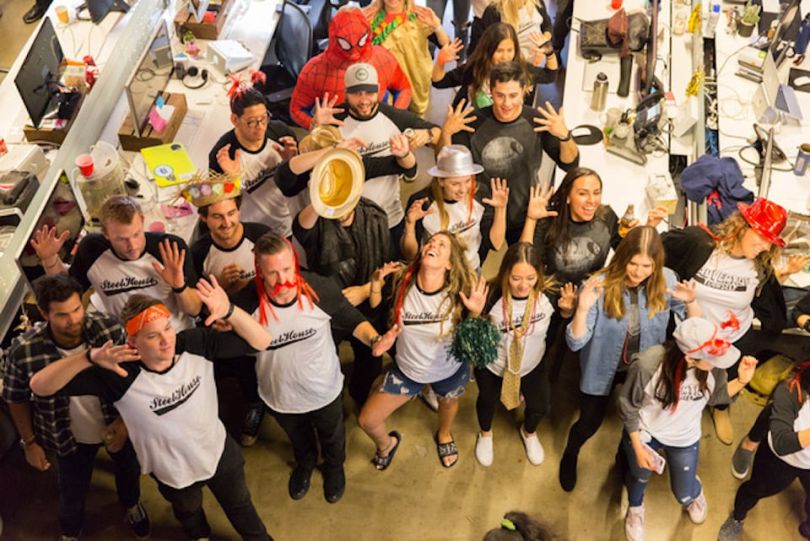Shortly before the end of his legendary career, Dodgers broadcaster Vin Scully lamented — in the self-deprecating, yet lovable way that endeared him to thousands of sports fans — that in his 67-years calling baseball games, he was never promoted. Not once.
The likelihood for someone who works in tech to be promoted is pretty high, but that doesn’t mean it’s a given. Some employees want stability, some want success and some want to help their team win. In the case of these four techies, the path to promotion meant identifying problems no one else saw, remaining humble and — perhaps most importantly — actively listening.
El Segundo-based digital marketing agency Wpromote has made promoting from within a priority. No one is a better example of this practice than GM of SEO and Content Marketing Andrew McLellan, who joined the company as an intern and has since become one of the company’s senior executives.
Time with the company: 9 years
Growth trajectory: PPC intern to SEO specialist > SEO manager to director of SEO > senior director of SEO > GM of SEO and content marketing
What drew you to Wpromote?
When I first started, Wpromote was a small, unestablished startup. The growth of a company was super exciting to me, especially in a burgeoning industry like digital marketing. I had also heard great things from a few people who worked there, and they were one of the few paid internship programs available, which was really the only way I could afford to give it a shot.
Was the potential for growth something that drove you? Or was your growth the result of consistently getting results?
I came back to Wpromote after college and started learning as much as I could while doing right by my clients. After a few years, my boss left for an MBA program and I was really down about it since he had been so great to me, but the situation ended up being a huge opportunity for my own growth. I was never really driven by that type of growth — I really just wanted to figure out where I could most benefit the company.
What’s one specific lesson you learned along the way you try to share with your fellow employees?
Be patient, and really listen when you receive feedback. I’ve made a lot of mistakes in my career but I always try to avoid making the same mistake twice. Remember that anyone giving you feedback is looking out for your best interest. Try to not be defensive and really hear what the people around you are saying.
What does the company’s dedication to helping employees succeed say about the culture?
We promote internally a lot, and this comes from a culture of success and growth. We try to do right by loyal employees, empowering the right people to move into roles that best fit their skills. We aim to be a meritocracy, and I think it shows, not only in employee satisfaction but also in the results that our team produces.

Nine months ago, joined Santa Monica-based software developer SimplePractice as a business development manager. Today, her role as manager of strategic initiatives means she is responsible for the direction of several different projects in addition to sitting on the leadership team.
Time with the company: 9 months
Growth trajectory: Business development manager > manager, strategic initiatives
Was the potential for growth something that drove you? Or was your growth the result of consistently getting results?
I didn’t join the company with the mindset of rising through the ranks or getting promoted. My main focus was to figure out what needed to be done and do it the best way I could. I quickly realized that things move fast and people are busy, so I decided to take the initiative to prioritize action and make decisions.
I actually joined SimplePractice with the mindset that I was in charge of business development — a team of one — and approached it as if I was the department head. I was later told that my mindset of taking ownership and being a leader is what prompted my manager [CEO Howard Spector] to promote me and include me on the leadership team.
How does your experience growing from position-to-position influence your leading style?
The biggest shift was going from an individual contributor to a manager, leading a team of individual contributors. There is still a learning curve, but I’m getting the hang of how my leadership style needs to shift.
As an individual contributor, I was both responsible and accountable for delivery value. It was a very independent effort where I had complete control over every aspect of what needed to get done. My leadership was focused more on collaborating across teams and building trust and respect from my colleagues as a new employee.
In this new role, I maintain accountability for everything but rely heavily on the team to deliver. It’s a new dynamic, my leadership is focused on supporting the team; removing blockers, making sure they feel empowered in their roles, and providing direction. I’ve also focused on identifying and leveraging team member strengths to help the team be as effective as possible.
What’s one specific lesson you learned along the way you try to share with your fellow employees?
My natural inclination is to plan — I love a good strategy. I learned early on that, while this strategy was appreciated, it isn’t rewarded in the same way as actually taking action. I quickly shifted my approach to only plan enough to thoughtfully take action and prioritized delivering results over delivering a plan. This was an incredibly valuable shift in my mindset that helped me to be successful in this fast-paced, action-oriented company.

Jake Sigrist joined Pasadena-based Redgate Software not long after graduating from Chapman University in 2014. Since then, Sigrist has gone from an inside sales representative to leading Redgate’s Americas sales development representative team, but if you ask him, the journey wasn’t as much a matter of becoming a leader, but rather growing as a professional with each new responsibility handed to him.
Time with the company: 3.5 years
Growth trajectory: Inside sales representative > business development representative > account executive > sales manager – AMER SDR
What drew you to Redgate?
I did not have sales experience before applying to Redgate, which meant that I was looking at a ton of different companies in the LA area. Almost immediately, Redgate stood out from the pack — this company builds products that provide real value to our clients.
What really hooked me was the company culture. I’m skeptical of a lot of places out there that advertise great culture and perks, but at Redgate, it’s much more than cool office spaces and wearing t-shirts to work. Investment in personal and career development is what makes our culture special.
Was the potential for growth something that drove you? Or was your growth the result of consistently getting results?
It’s really a combination of both — you can’t have one without the other. Getting results is what we always look for at the end of the day, but there’s usually a certain amount of personal growth that needs to take place before someone is capable of achieving those results.
You set an ambitious goal, stretch yourself to get better to meet that goal, and, ultimately, achieve that goal. You then set an even more ambitious goal and repeat that process. Over time, you will be able to look back and see the progress you’ve made. This process of incremental improvements and the support Redgate has provided along the way have really helped me develop my career.
What’s one specific lesson you learned along the way you try to share with your fellow employees?
Do not try and eat the apple in one bite. If you have lofty ambitions, make sure to plan out the series in small steps that will lead you to the top.

In a little more than seven years with Culver City-based adtech company SteelHouse, Chief Operating Officer Chris Innes has gone from a team lead to a C-level position. Though his title has changed a handful of times, his hands-off approach to leadership has not.
Time with the company: 7 years
Growth trajectory: Lead, customer service > lead, Steelhouse Europe > SVP client services > chief monetization officer > chief operating officer
Was the potential for growth something that drove you? Or was your growth the result of consistently getting results?
Two things really drove me over the last seven years, and continue to drive me today. First, we have an approach focused on continuously finding and solving new problems. It doesn’t matter if we’re having our best quarter ever — we approach every day trying to find a better way. Second, when you are surrounded by great people and a culture focused on the people, it’s rewarding to come to work.
How does your experience growing from position-to-position influence your leading style?
I may have been part of a few different teams and roles, but leadership really isn’t that different. I’ve found that people tend to follow people they want to follow. Leadership isn’t forced down someone’s throat. I’ve also found leaders continually remind their teams of the direction and let the team figure out how to get there.







